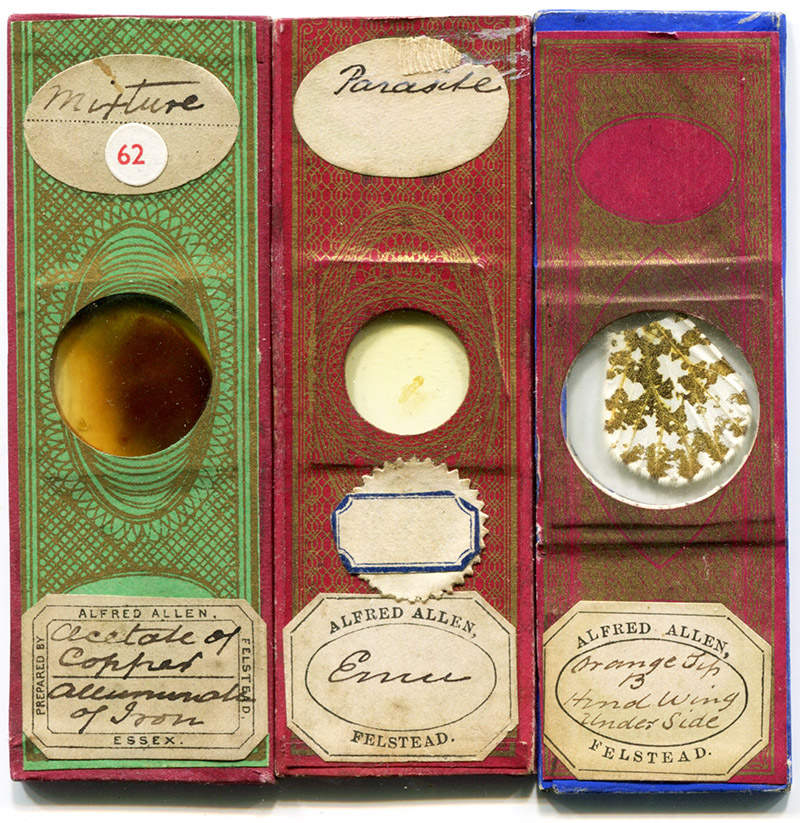
Figure 1. Microscope slides by Alfred Allen. He lived in Felstead (Felsted), Essex, from 1861 until ca. 1876.
Alfred Uriah Allen, 1833-1898
by Brian Stevenson
last updated November, 2020
Alfred Allen is best remembered as one of the founders of The Postal Microscopical Society, and Editor of the society’s Journal of the Postal Microscopical Society / Journal of Microscopy and Natural Science.
He was an avid amateur microscopist from at least the late 1860s onward, preparing a wide variety of specimens (Figures 1-4). A notable slide that Allen offered for exchange/sale contains particles of soot from a coke fire, advertised as a subject for polariscopic examination (Figure 2). Allen’s slides are occasionally seen that have custom-printed cover papers which bear his initials (Figure 3).

Figure 1.
Microscope slides by Alfred Allen. He lived in Felstead (Felsted), Essex, from 1861 until ca. 1876.
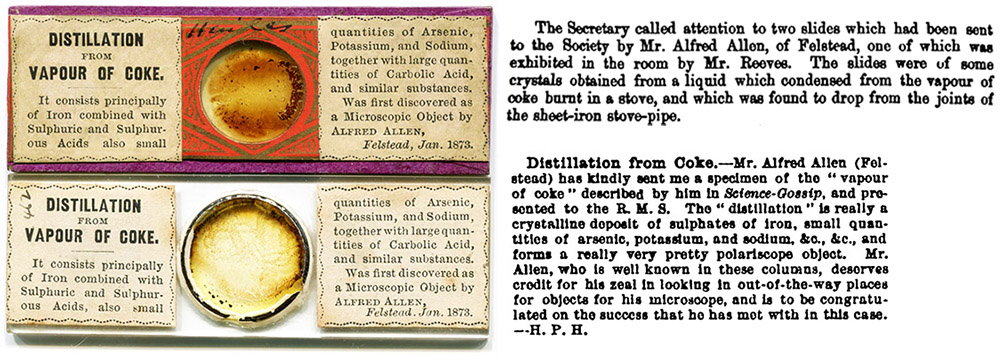
Figure 2.
Circa 1873 slides by A. Allen of “Distillation from vapour of coke”. He presented sample slides to the Royal Microscopical Society, Quekett Microscopical Club, and others during early 1873. Shown alongside the slides are notes from the R.M.S. and by Henry Pocklington (“H.P.H.”), writing in “The English Mechanic and World of Science. The “distillation” is actually particles of burnt minerals that collected in joints of a stove pipe. Pocklington wrote that Allen “deserves credit for his zeal in looking in out-of-the-way places for objects for his microscope, and is to be congratulated on the success that he has met with in this case”.
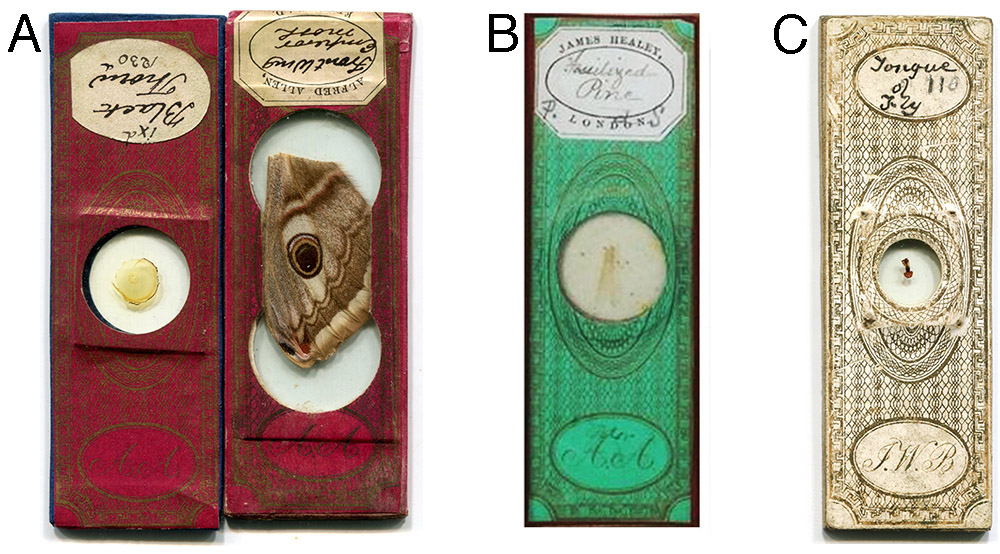
Figure 3.
(A) Uncommon Allen slides with his monogrammed paper, which probably date from the 1860s. (B) A slide by James Healey, of London, that bears Allen’s monogrammed cover paper and a descriptive label that is essentially the same as Allen’s. To-date, nothing is known about Healey’s identity or his relationship to Allen. (C) A slide by professional mounter James William Bond (1803-1887). The cover paper is of the same pattern as that used by Alfred Allen, suggesting that their papers came from the same print works. Bond lived in Bethnal Green, in northeastern London. Adapted for nonprofit, educational purposes from an internet auction site, or from private collections.
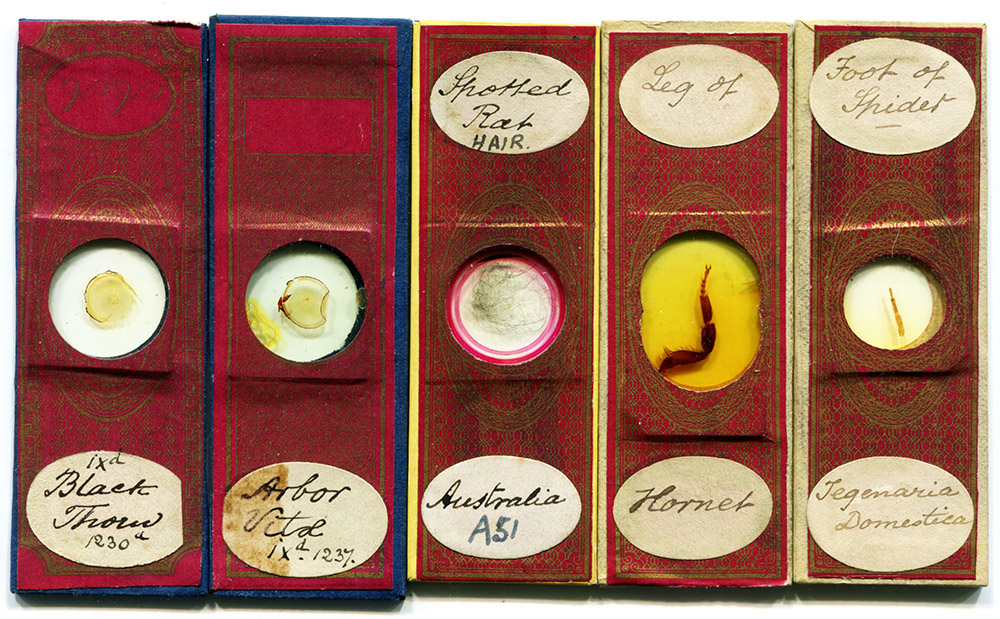
Figure 4.
Some unsigned slides by Alfred Allen, recognizable by his handwriting on the labels, and compared to an Allen slide with his monogrammed cover paper (far left).
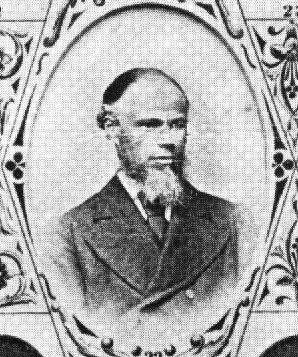
Figure 5.
Alfred Allen, photographed during the early 1870s. In 1874, The Postal Microscopical Society requested that all members provide a photograph of themselves, which were then used to produce a collage to be distributed as a way of “introducing” members to each other.
Alfred Uriah Allen was born on August 16, 1833, in Cambridge, England. He was the elder child of Charles and Sarah Allen. A sister, Sarah, was born three years later. Charles’ business as a bookbinder was evidently a financial success, as the family enjoyed the services of a domestic servant.
As a teenager, Alfred was apprenticed as a grocer and draper with John Dawson in Ely. Dawson had a substantial business: at the time of the 1851 census, his household included two sons who were also drapers, two other journeyman drapers, two journeyman grocers, a “cashier”, and a second apprentice.
After that training, Allen established himself as a “grocer and baker” in Histon, Cambridgeshire. He married Clara Bentall in 1859, and the pair had one child, Emily, born in 1860
The 1861 census recorded that Alfred Allen then employed “1 man and 1 apprentice”. His father had died in 1857, so his widowed mother lived with him. She was reported to be drawing income as a “proprietor of houses” (i.e. landlady collecting rents). A domestic servant assisted them.
Later in 1861, he moved to Felsted, Essex, and opened another grocery business. A later record described him as also being a “wine merchant”.
Notes published in popular scientific magazines indicate that Alfred Allen developed a number of interests beside microscopy, including insect collecting and preparing magic lantern slides. An 1869 letter from Allen described an infestation of his insect collection, along with an offer to share hairs/setae from the invader (Figure 6).
In 1870, Allen offered to exchange mounts of sheep “ticks” (actually insects, more accurately known as keds) (Figure 7). Within a couple of years, he began offering preparations of chemical crystals. As noted above, in 1873 he began producing slides from “vapour of coke”. These latter slides are especially notable by having type-set labels that describe the specimen (Figure 2).
Also in 1873, Alfred Atkinson (1843-1927), a civil engineer in Glanford Brigg, Lincolnshire, wrote an open letter to Hardwicke’s Science-Gossip, proposing “a postal cabinet association”, wherein members could share boxes of microscope slides among themselves. Alfred Allen quickly responded to Atkinson’s idea, along with additional plans for organizing such a group. By the end of the year, The Postal Micro-Cabinet Club had been formed, with Atkinson as President and Allen as Secretary. Allen described the concept as follows:
“Many of the readers of Science-gossip will remember that in the May number there appeared a suggestion respecting the formation of a circulating cabinet for microscopic objects. As the address of Mr. Atkinson, the writer of the notice, was not inserted, I was unable to write to him privately, and too busy to reply through your pages at that time; but I did so in August, and at the same time stated that if Mr. Atkinson would favour me with his address I felt sure I could find him six gentlemen who would be willing to join in so pleasing an undertaking. I then set to work to look up my half-dozen friends, and when towards the end of August I received a letter from Mr. A., instead of six I had found thirty members, and had also roughly framed a set of rules. We have now a club formed of thirty-six members, who are divided into three circuits, which we call Northern, Central, and Southern; Mr. Atkinson, the first proposer, being our president. Our method of proceeding in the first instance is this: an empty box is sent to first member on each circuit, who places in it a slide and sends it on to the next, who does the same, &c. &c. The twelfth member, who puts last slide into the box, instead of returning it to first member, will send it to Hon. Sec., who will send it round next circuit, then the next: and when it has been the entire circuit of the club it will again be sent to first member, who will take out his own slide and replace it by another. When it is conjectured that each box has gone half round its own circuit another box will be started again, so when the club is in thorough working order each member will be supposed to receive a box about once a week. Suggestions, hints, and criticisms are requested from all the members: from these I hope, as opportunity offers, to cull little scraps of information that may from time to time enrich the pages of Science Gossip”.
Two years later, Atkinson had been replaced as President by Tuffen West (1823-1891), a Fellow of the Royal Microscopical Society and the Linnaean Society, and a noted illustrator of microscopical objects.
Alfred Allen became a Fellow of the Royal Microscopical Society on April 7, 1875. Records from 1877 onward do not give Allen the initials “F.R.M.S.”, implying that he resigned his membership within a year or two of joining. That would also correspond with the time of his move across England to Bath.
In July, 1876, Allen advertised to sell “a complete set” of bookbinder’s tools. Presumably these had been inherited from his father. The sale of this large amount of cumbersome equipment probably presaged Allen’s cross-country move.
By November, 1878, at the latest, Alfred Allen was living at 1 Cambridge Place, Bath, and remained there through the end of his life. The 1881 census listed the 47 year-old Allen as a “retired wine merchant”. An 1888 publication referred to Allen as being in poor health, so he probably retired from his business due to illness. Bath was a spa town, where people often went for its “healthy” mineral waters. Allen could evidently afford to retire from active employment, as he, Clara, and their daughter employed a domestic servant. Additionally, Clara’s unmarried sister, Harriet, lived with them and was listed in the 1881 and 1891 censuses as living off “interest of money”.
In 1882, Allen began publication of The Journal of the Postal Microscopical Society (the club had changed its name around 1879) (Figure 8). Within two years, the title was changed to a more broadly encompassing Journal of Microscopy and Natural Science.
Allen started a second magazine in 1886, The Scientific Enquirer (Figure 9). This venture lasted for almost three years. In January, 1888, Allen wrote in this journal that “the amount of labour entailed is more than we feel justified in imposing upon ourselves and friends”, and planned to cancel publication at that time. Supporters rallied him to continue with the enterprise, but ill health compelled him to cease by late autumn: “In the November number of ‘The Scientific Enquirer’ (the monthly supplement of the Quarterly ‘Journal of Microscopy and Natural Sciences’) Mr. Alfred Allen, the editor and proprietor, announces that by order of his physicians he is compelled to cease publication of the former journal. We sincerely regret this fact, not only on account of the cause which requires it, but on account of the loss of the bright little journal that for two years past regularly visited our table. We earnestly hope that Mr. Allen may soon regain his health and strength and resume publication of ‘The Scientific Enquirer’. ”
Allen was joined in 1889 by William Spiers (1847-1930), who had been publishing The Wesley Naturalist, merging their publications into a new version of The Journal of Microscopy and Natural Science. Spiers left the partnership in 1891. Allen wrote, “In writing the closing sheet of our Journal for the current year, I have with feelings of much regret to announce the retirement from the co-editorship of my esteemed friend, the Rev. W. Spiers, M.A., whose many other engagements render it impossible for him to continue the duties of this position. Whilst sincerely thanking him for his services during the past two years, I beg to inform our numerous readers and contributors - whose numbers, I am pleased to say, are steadily increasing - that I shall again take, as I had for the eight previous years, the sole charge and control of the Journal”.
By 1897, the publication had become too much for Allen to handle, and it ceased to exist after volume 16. Allen wrote, “during the whole of those sixteen years I can honestly say that I have spared no labour to make it worthy of the name it bears. That I have succeeded in winning the approbation of a great number of subscribers I have many letters to prove. But for several years the result of the sales has not been sufficient to pay the printer's bills, and this year I feel myself so far in arrears that I dare go on no further”. Science-Gossip later wrote, “It is understood that the journal was not self-supporting, but Mr. Allen himself willingly undertook its publication until failing health obliged him to discontinue its issue in 1897”.
Nonetheless, Allen remained an eager officer of the Postal Microscopical Society. His farewell to the publication ended with “I trust the discontinuance of the Journal will not in any way interfere with the steady and efficient working of the Postal Microscopical Society, which will hold its Annual Meeting at the Holborn Restaurant on Thursday evening, the 21st inst. All friends of the Society and of the Journal will be welcome to attend. For particulars and Tickets apply to me”.
Alfred Allen on March 24, 1898, at the age of 64.
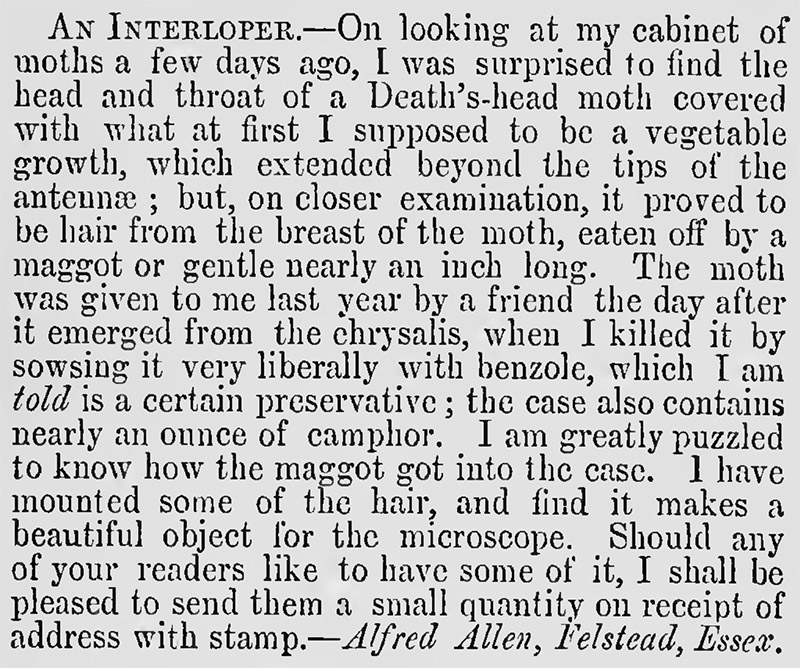
Figure 6.
An 1869 note from Alfred Allen, describing an infestation of his insect collection, and an offer to provide hairs from the invading creature. From “Hardwicke’s Science-Gossip”.
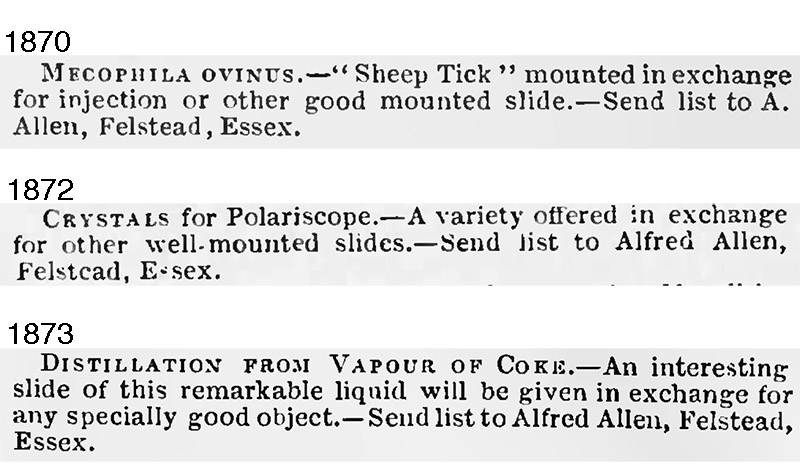
Figure 7.
Exchange offers by Alfred Allen, from “Hardwicke’s Science-Gossip”.
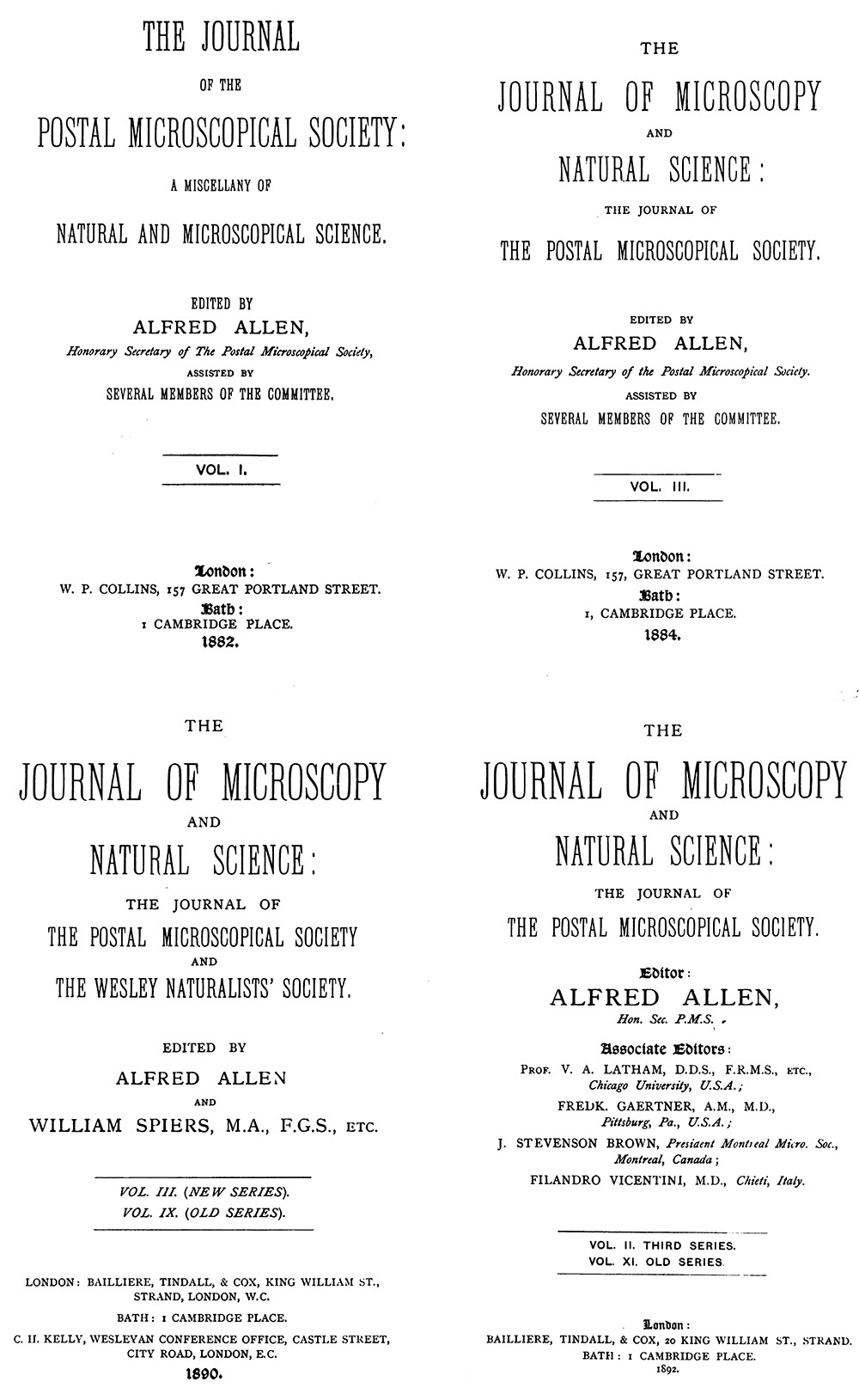
Figure 8.
Cover pages of the magazines that Alfred Allen published for the Postal Microscopical Society.
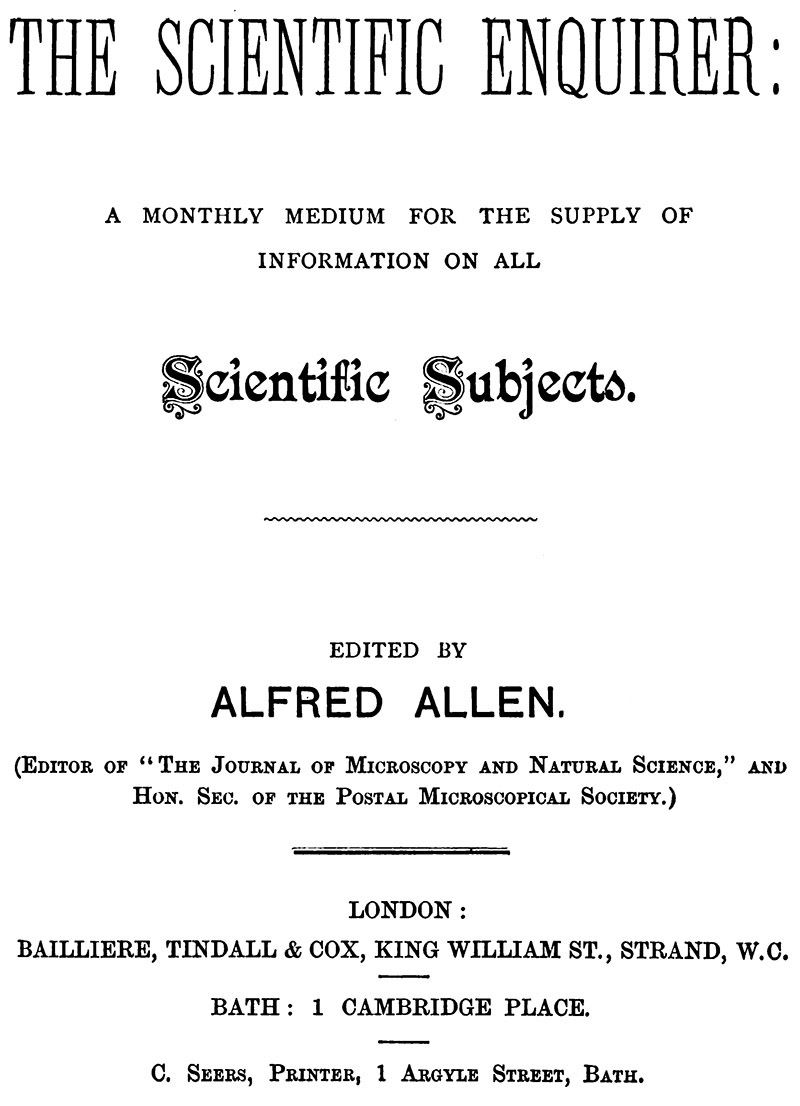
Figure 9.
Cover page of the first issue of Alfred Allen’s’ monthly magazine, “The Scientific Enquirer”.
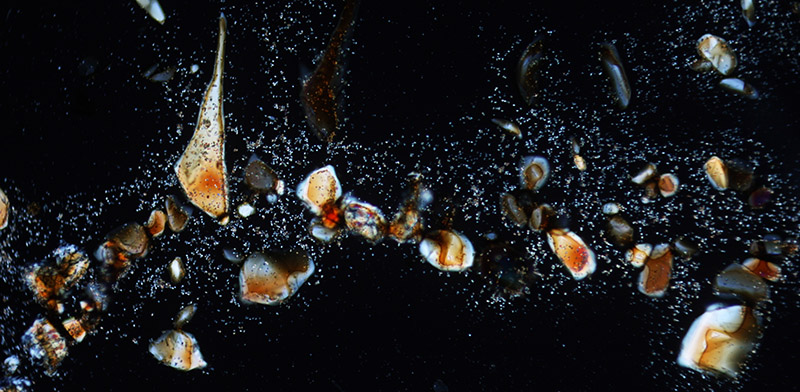
Figure 10.
“Distillation from vapour of coke”, viewed between crossed polarizing filters with a 10x objective lens (see Figure 2).
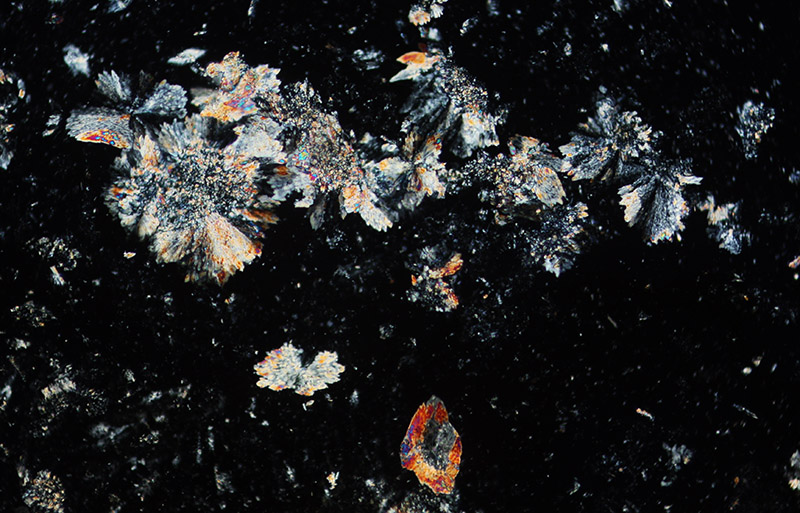
Figure 11.
“Mixture of acetate of copper and aluminate of iron”, from a ca. 1872 microscope slide by Alfred Allen (see Figure 1). Photographed with a 10x objective lens, C-mounted digital SLR camera, and crossed polarizing filters.
Resources
Allen, Alfred (1868) Painting slides, English Mechanics and Mirror of Science, page 267
Allen, Alfred (1869) An interloper, Hardwicke’s Science-Gossip, Vol. 5, page 140
Allen, Alfred (1869) Emperor moth, Hardwicke’s Science-Gossip, Vol. 5, page 257
Allen, Alfred (1873) Microscopic postal cabinets, Hardwicke’s Science-Gossip, Vol. 9, page 191
Allen, Alfred (1873) Crystals of willow, Hardwicke’s Science-Gossip, Vol. 9, page 207
Allen, Alfred (1873) The Postal Micro-Cabinet Club, Hardwicke’s Science-Gossip, Vol. 9, pages 281-282
Allen, Alfred (1878) The Postal Microscopical Society, British Medical Journal, Vol. 2, page 819
Allen, Alfred (1891) Editorial comments, The Journal of Microscopy and Natural Science, Vol. 10, pages iii-iv
Allen, Alfred (1897) Preface, The Journal of Microscopy and Natural Science, Vol. 16, pages v-vi
Atkinson, Alfred (1873) Microscopic postal cabinets, Hardwicke’s Science-Gossip, Vol. 9, page 111
Bookseller (1876) Sale advertisement from Alfred Allen, Vol. 19, page 643
Bracegirdle, Brian (1998) Microscopical Mounts and Mounters, Quekett Microscopical Club, Lon, pages 2 and 110, and Plates 3_K and 3-L
England census and other records, accessed through ancestry.com
Hardwicke’s Science-Gossip (1870) Exchange offer from A. Allen, Vol. 6, page 192
Hardwicke’s Science-Gossip (1871) Exchange offer from A. Allen, Vol. 7, page 284
Hardwicke’s Science-Gossip (1872) Exchange offer from A. Allen, Vol. 8, page 264
Hardwicke’s Science-Gossip (1873) Exchange offers from A. Allen, Vol. 9, page 24, 72, and 120
The Journal of the Quekett Microscopical Club (1873) Vol. 3, page 150
The Journal of the Quekett Microscopical Club (1875) Vol. 4, page 127
������������������������������������������������������������������������������������The Midland Naturalist (1879) Vol. 2, Pages 49-50
The Monthly Microscopical Journal (1873) pages 125 and 130
The Monthly Microscopical Journal (1875) page 227
Natural Science (1898) “Among other losses to science we note the following :-On March 24, aged 64, Alfred U. Allen of Bath, who was the secretary of the Postal Microscopical Society, and editor since 1882 of the Journal of Microscopy and Natural Science, the cessation of which we noticed a short time ago”, Vol. 12, page 422
Science-Gossip (1900) Postal Microscopical Society, New series, Vol. 7, page 88
St. Louis Medical and Surgical Journal (1888) Discontinued, Vol. 54, page 29
Pocklington, Henry (1873) Distillation from coke, The English Mechanic and the World of Science, Vol. 17, page 458 (writing as “H.P.H.”)
Post Office Directory Essex (1861) page 84
Probate of the will of Alfred Allen (1898) “Allen Alfred Uriah of 1 Cambridge-place Bath gentleman died 24 March 1898 Probate Bristol 2 May to Clara Allen widow and Emily Mary Allen spinster Effects £3821 11s 1d”, accessed through ancestry.com
Samworth, Mike (2020) The Postal Microscopical Society (PMS) during lockdown, https://www.quekett.org/about/reports/2020-exhibition-public/2020-lockdown-public/mike-samworth-2020-public
Sessions, R.H. (1971) A century of postal microscopy, the history of the Postal Microscopical Society, Journal of the Quekett Microscopical Club, Vol. 32, pages 225 - 241